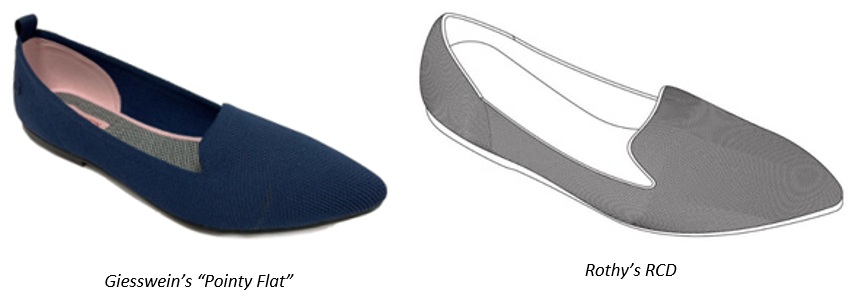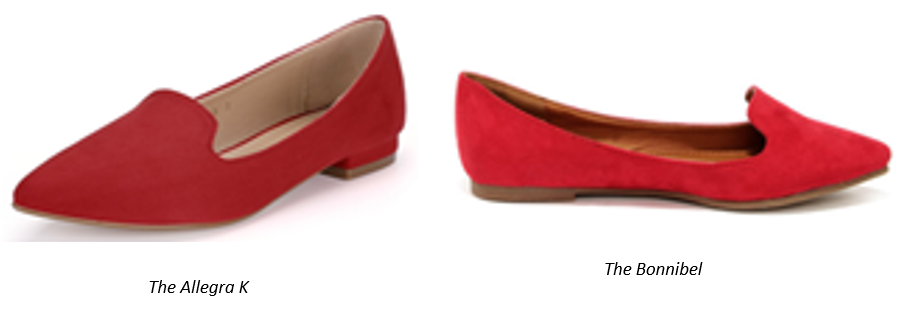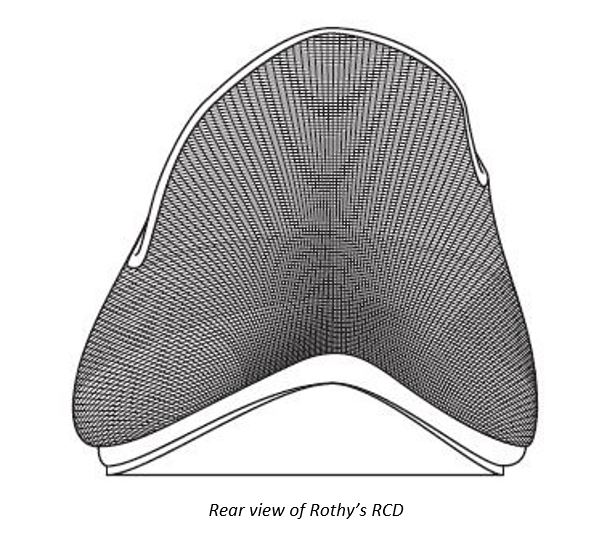In this article for Intellectual Property Magazine, Mathys & Squire associate Max Thoma and technical assistant Oliver Parish consider the importance of drawings in determining the scope of a registered design.
In this recent design case – Rothy’s Inc v Giesswein Walkwaren AG [2020] EWHC 3391 (IPEC) – before the Intellectual Property Enterprise Court (IPEC), the judge decided that the Austrian company Giesswein Walkwaren AG’s “Pointy Flat” shoe infringed a Registered Community Design (RCD) held by the California-based fashion company Rothy’s Inc.
Background
Rothy’s claimed that Giesswein’s knitted “Pointy Flat” shoe (pictured below) infringed its RCD (also pictured below) as well as its Unregistered Community Design (UCD) rights subsisting in its own knitted “Pointed Loafer” shoe. Both of the “Pointy Flat” and “Pointy Loafer” shoes were made of a knitted fabric.

Giesswein counterclaimed for invalidity of Rothy’s RCD on the basis of two prior designs, the “Allegra K” and the “Bonnibel” shoes (pictured below). Both the “Allegra K” and the “Bonnibel” were made from suede (or variants thereof).

The Registered Community Design
The pivotal issue in dispute was how to interpret the fine black lines shown on the shoe upper in Rothy’s RCD.

The defendant, Giesswein, argued that the black lines merely showed that the shoe is a three-dimensional shape, and that if the black lines did indicate any surface design feature, that feature was a textured appearance generally (including any knitted, woven or animal hide materials, but excluding smooth textures) rather than any specific material.
The claimant, Rothy’s, encouraged the Judge to zoom in on the high-resolution digital images of the RCD which show that the black lines radiate in a circular pattern at the heel and toe of the shoe. Such a pattern, it was argued, is specifically indicative of a knitted fabric rather than a textured appearance more generally.
The judge agreed with the claimant, noting that certain aspects of the patterning of the lines were inconsistent with a woven fabric or unprinted animal hide such as nubuck or suede. The lines were therefore held to indicate a knitted fabric (such as that present in the “Pointy Flat” shoe), rather than any of the alternative textures suggested by the defendant.
The judge went on to find that, whilst knitted fabrics were known for shoe uppers on gym shoes and sneakers, the notional informed user would not be aware that they had been applied to the types of shoe in question. The use of a knitted fabric on such a shoe would thus stand out to the informed user as a significant departure from existing designs.
As such, the judge decided that the “Allegra K” and “Bonnibel” suede shoes of the prior art would produce a different overall impression on the informed user than the knitted shoe of the RCD. For this reason, the RCD was found to be valid.
Similarly, the judge decided that the knitted shoe of the RCD would produce the same overall impression on the informed user as Giesswein’s knitted “Pointy Flat” shoe. Giesswein’s “Pointy Flat” shoe was therefore found to infringe the RCD.
The Unregistered Community Design
For similar reasons, it was decided that the UCD subsisting in Rothy’s own knitted “Pointed Loafer” shoe produced the same overall impression on the informed user as Giesswein’s knitted “Pointy Flat” shoe, and a different overall impression than the suede shoes of the prior art.
However, on the question of whether Giesswein’s “Pointy Flat” shoe was copied from Rothy’s “Pointed Loafer” – an essential criterion for establishing infringement of the UCD – the judge decided that the designers of Giesswein’s shoe had sufficiently explained how the shoe was independently designed. Therefore, Rothy’s UCD was found to be valid but not infringed.
Practical guidance
Rothy’s succeeded in their registered design claim due to their carefully prepared design drawings, which effectively gave them IP protection over the material and texture of their shoes.
This decision serves as a reminder, further to PMS International Group Plc v Magmatic Limited (i.e. the “Trunki” case), as to the importance of the drawings of a registered design. Care should be taken in the preparation of suitable drawings for a registered design application so as to optimise the scope of protection provided. Creative design drawings should also be considered to protect important features. This decision also shows that that a Court may ‘zoom in’ to design drawings to look at subtle details – emphasising the importance of high-resolution images showing such details.
Lastly, while this decision relates to the infringement and validity of Community (EU) registered and unregistered designs (which, following the end of the Brexit transition period, would no longer extend to the UK), it is still relevant under UK practice (as are other decisions relating to EU design law). This because the UK legal provisions governing the infringement and validity of UK registered and unregistered designs are very similar to those that related to EU registered and unregistered designs.
This article was originally published in Intellectual Property Magazine in March 2021.

